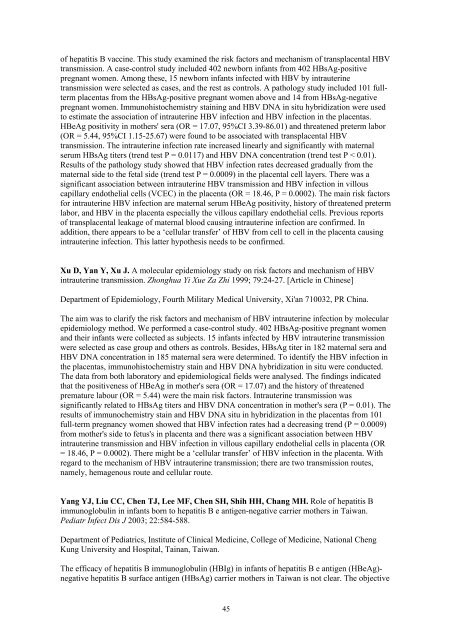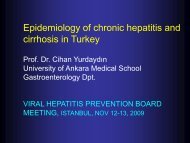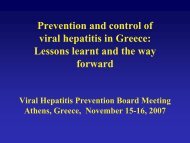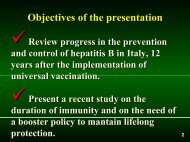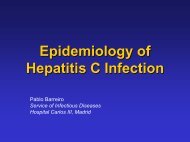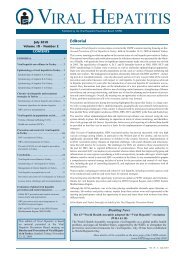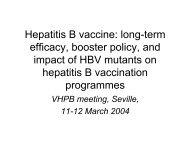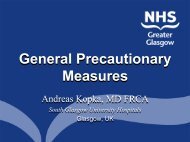Prevention and control of perinatal hepatitis B virus transmission in ...
Prevention and control of perinatal hepatitis B virus transmission in ...
Prevention and control of perinatal hepatitis B virus transmission in ...
Create successful ePaper yourself
Turn your PDF publications into a flip-book with our unique Google optimized e-Paper software.
<strong>of</strong> <strong>hepatitis</strong> B vacc<strong>in</strong>e. This study exam<strong>in</strong>ed the risk factors <strong>and</strong> mechanism <strong>of</strong> transplacental HBV<strong>transmission</strong>. A case-<strong>control</strong> study <strong>in</strong>cluded 402 newborn <strong>in</strong>fants from 402 HBsAg-positivepregnant women. Among these, 15 newborn <strong>in</strong>fants <strong>in</strong>fected with HBV by <strong>in</strong>trauter<strong>in</strong>e<strong>transmission</strong> were selected as cases, <strong>and</strong> the rest as <strong>control</strong>s. A pathology study <strong>in</strong>cluded 101 fulltermplacentas from the HBsAg-positive pregnant women above <strong>and</strong> 14 from HBsAg-negativepregnant women. Immunohistochemistry sta<strong>in</strong><strong>in</strong>g <strong>and</strong> HBV DNA <strong>in</strong> situ hybridization were usedto estimate the association <strong>of</strong> <strong>in</strong>trauter<strong>in</strong>e HBV <strong>in</strong>fection <strong>and</strong> HBV <strong>in</strong>fection <strong>in</strong> the placentas.HBeAg positivity <strong>in</strong> mothers' sera (OR = 17.07, 95%CI 3.39-86.01) <strong>and</strong> threatened preterm labor(OR = 5.44, 95%CI 1.15-25.67) were found to be associated with transplacental HBV<strong>transmission</strong>. The <strong>in</strong>trauter<strong>in</strong>e <strong>in</strong>fection rate <strong>in</strong>creased l<strong>in</strong>early <strong>and</strong> significantly with maternalserum HBsAg titers (trend test P = 0.0117) <strong>and</strong> HBV DNA concentration (trend test P < 0.01).Results <strong>of</strong> the pathology study showed that HBV <strong>in</strong>fection rates decreased gradually from thematernal side to the fetal side (trend test P = 0.0009) <strong>in</strong> the placental cell layers. There was asignificant association between <strong>in</strong>trauter<strong>in</strong>e HBV <strong>transmission</strong> <strong>and</strong> HBV <strong>in</strong>fection <strong>in</strong> villouscapillary endothelial cells (VCEC) <strong>in</strong> the placenta (OR = 18.46, P = 0.0002). The ma<strong>in</strong> risk factorsfor <strong>in</strong>trauter<strong>in</strong>e HBV <strong>in</strong>fection are maternal serum HBeAg positivity, history <strong>of</strong> threatened pretermlabor, <strong>and</strong> HBV <strong>in</strong> the placenta especially the villous capillary endothelial cells. Previous reports<strong>of</strong> transplacental leakage <strong>of</strong> maternal blood caus<strong>in</strong>g <strong>in</strong>trauter<strong>in</strong>e <strong>in</strong>fection are confirmed. Inaddition, there appears to be a ‘cellular transfer’ <strong>of</strong> HBV from cell to cell <strong>in</strong> the placenta caus<strong>in</strong>g<strong>in</strong>trauter<strong>in</strong>e <strong>in</strong>fection. This latter hypothesis needs to be confirmed.Xu D, Yan Y, Xu J. A molecular epidemiology study on risk factors <strong>and</strong> mechanism <strong>of</strong> HBV<strong>in</strong>trauter<strong>in</strong>e <strong>transmission</strong>. Zhonghua Yi Xue Za Zhi 1999; 79:24-27. [Article <strong>in</strong> Ch<strong>in</strong>ese]Department <strong>of</strong> Epidemiology, Fourth Military Medical University, Xi'an 710032, PR Ch<strong>in</strong>a.The aim was to clarify the risk factors <strong>and</strong> mechanism <strong>of</strong> HBV <strong>in</strong>trauter<strong>in</strong>e <strong>in</strong>fection by molecularepidemiology method. We performed a case-<strong>control</strong> study. 402 HBsAg-positive pregnant women<strong>and</strong> their <strong>in</strong>fants were collected as subjects. 15 <strong>in</strong>fants <strong>in</strong>fected by HBV <strong>in</strong>trauter<strong>in</strong>e <strong>transmission</strong>were selected as case group <strong>and</strong> others as <strong>control</strong>s. Besides, HBsAg titer <strong>in</strong> 182 maternal sera <strong>and</strong>HBV DNA concentration <strong>in</strong> 185 maternal sera were determ<strong>in</strong>ed. To identify the HBV <strong>in</strong>fection <strong>in</strong>the placentas, immunohistochemistry sta<strong>in</strong> <strong>and</strong> HBV DNA hybridization <strong>in</strong> situ were conducted.The data from both laboratory <strong>and</strong> epidemiological fields were analysed. The f<strong>in</strong>d<strong>in</strong>gs <strong>in</strong>dicatedthat the positiveness <strong>of</strong> HBeAg <strong>in</strong> mother's sera (OR = 17.07) <strong>and</strong> the history <strong>of</strong> threatenedpremature labour (OR = 5.44) were the ma<strong>in</strong> risk factors. Intrauter<strong>in</strong>e <strong>transmission</strong> wassignificantly related to HBsAg titers <strong>and</strong> HBV DNA concentration <strong>in</strong> mother's sera (P = 0.01). Theresults <strong>of</strong> immunochemistry sta<strong>in</strong> <strong>and</strong> HBV DNA situ <strong>in</strong> hybridization <strong>in</strong> the placentas from 101full-term pregnancy women showed that HBV <strong>in</strong>fection rates had a decreas<strong>in</strong>g trend (P = 0.0009)from mother's side to fetus's <strong>in</strong> placenta <strong>and</strong> there was a significant association between HBV<strong>in</strong>trauter<strong>in</strong>e <strong>transmission</strong> <strong>and</strong> HBV <strong>in</strong>fection <strong>in</strong> villous capillary endothelial cells <strong>in</strong> placenta (OR= 18.46, P = 0.0002). There might be a ‘cellular transfer’ <strong>of</strong> HBV <strong>in</strong>fection <strong>in</strong> the placenta. Withregard to the mechanism <strong>of</strong> HBV <strong>in</strong>trauter<strong>in</strong>e <strong>transmission</strong>; there are two <strong>transmission</strong> routes,namely, hemagenous route <strong>and</strong> cellular route.Yang YJ, Liu CC, Chen TJ, Lee MF, Chen SH, Shih HH, Chang MH. Role <strong>of</strong> <strong>hepatitis</strong> Bimmunoglobul<strong>in</strong> <strong>in</strong> <strong>in</strong>fants born to <strong>hepatitis</strong> B e antigen-negative carrier mothers <strong>in</strong> Taiwan.Pediatr Infect Dis J 2003; 22:584-588.Department <strong>of</strong> Pediatrics, Institute <strong>of</strong> Cl<strong>in</strong>ical Medic<strong>in</strong>e, College <strong>of</strong> Medic<strong>in</strong>e, National ChengKung University <strong>and</strong> Hospital, Ta<strong>in</strong>an, Taiwan.The efficacy <strong>of</strong> <strong>hepatitis</strong> B immunoglobul<strong>in</strong> (HBIg) <strong>in</strong> <strong>in</strong>fants <strong>of</strong> <strong>hepatitis</strong> B e antigen (HBeAg)-negative <strong>hepatitis</strong> B surface antigen (HBsAg) carrier mothers <strong>in</strong> Taiwan is not clear. The objective45


